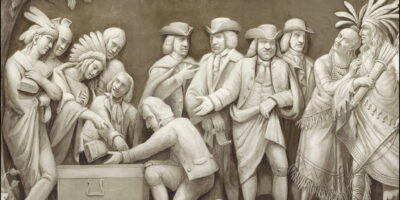What Can the Canadian Robber Barons Teach American Historians?
One commonly held view regarding American history is that, in the end of the 19th century, captains of industry enjoyed monopoly power and acted in ways that hurt the public. They were known as “trusts” and “robber barons.” This monopoly power was rectified in 1890 by the passage of the Sherman Antitrust Act, which allowed the government to step in, break up trusts, and promote competition.
Now, it is a little-known fact that Canada adopted a similar act a year before the Americans to deal with the “combines” (the Canadian equivalent to trusts). Canada also had its robber barons. The most fascinating part of the Canadian Anti-Combines Act of 1889 is that the story of its adoption mirrors to a great extent the American buildup to the adoption of the Sherman Antitrust Act.
In fact, the parallels are quite striking. The Canadian evidence matches up nearly perfectly with the evidence marshalled by those who question the narrative regarding trusts and robber barons in the United States.
Research by American economists and economic historians has shown that industries accused of being trusts actually benefited consumers. They increased production rapidly (faster than the rest of the economy) and reduced real prices for their wares and services. It is because of innovation and efficiency that they were able to capture large market shares. To be fair, trusts did try to develop strategies to collude, but market pressures, such as in the case of the “whiskey trust,” led them to disintegrate within a very short time window.
Most importantly, the passage of the Sherman Antitrust Act had more to do with firms that were being outcompeted by the more efficient and larger firms. Their hope was that the act would restrict their competitors and prevent them from being driven out of the market. Thus, under the guise of promoting competition, they were protecting themselves from competition.
Restraint of Trade in Canada
During the 1880s, Canadians were complaining in greater numbers about the proliferation of combines acting in restraint of trade. Accused combines such as the cotton industry were not hiding their activities either. In fact, they publicized them in newspapers such as the Montreal Gazette and the New York Times.
The topic made headlines when, during a hotly contested mayoral election in the city of Toronto, one of the candidates was accused of profiting from a combine in the distribution and retail of coal oil. It cost the candidate the election and prompted Nathaniel Clarke Wallace, an Orangist sitting as a conservatve member of Parliament, to launch an investigation into the combines in 1888.
This led to the formation of a parliamentary select committee that investigated combines affecting products such as barbed wire, coal, sugar, coffins, oatmeal, biscuits, watch cases, eggs, and barley. Certain parties complained that the cotton manufacturing sector had been excluded from the investigation even though the manufacturers often published reports of meetings in newspapers such as the Montreal Gazette, where they stated their aim to reduce production. This exclusion was probably the result of the industry’s political proximity to the Conservatives. The report acted as justification for the passage of the act in 1889.
The first parallel between Canada and the United States is that prices for goods in the vast majority of investigated sectors actually fell in real terms. In fact, some goods, such as sugar and coal, saw their prices fall by a third in the decade leading to the passage of the act. Prices of other goods such as barbed wire fell by half.
The second parallel is that for the vast majority of sectors for which output can be estimated, their production increased faster than the overall economy. These findings are exactly the same as those that economist Thomas DiLorenzo found when doing the same exercise for the industries accused of being trusts in the United States in the years preceding the adoption of the Sherman Antitrust Act.
The third parallel is that the firms that complained of combines were actually not complaining about the welfare of consumers. They were complaining that the competition was unfair. One example relates to the sale of coal in the national capital of Ottawa. The Ottawa Coal and Cartage Company developed a system for managing the distribution of coal which saved on the considerable costs of loading and unloading coal from trains and carts.
One merchant who testified to the Committee on Combines reported that he could not break even below $6 a ton in 1888 and he could not earn a “living profit” (a term used by historian Michael Bliss) at that price. However, in the same year, advertisements in the Ottawa Daily Citizen reported prices of $5.05 to $5.30 per ton for merchants associated with the Ottawa Coal and Cartage Company. These prices were down from $6.50 to $6.75 in 1881. This suggest that the merchant in question was unable to compete with more efficient players who were getting the loyalty of customers. This also mimics the findings of American economic historian Werner Troesken, who highlighted how inefficient firms were the ones pushing for the Sherman Act in the hope of hindering the more efficient firms.
The fourth parallel is that the industries that did try to collude were not able to do so. The best case is that of the cotton industry, which was often accused of being a combine but was not investigated by the committee. In the 1880s, there were numerous attempts to form a cartel. However, cartels are notoriously hard to maintain because output restrictions, leading to higher prices, invite some members to cheat and offer secret discounts to clients.
When the cotton cartel was formed, one member of the industry who had initially joined, the industrialist Alexander Gibson of New Brunswick, offered secret discounts. Later, Gibson would leave the cartel and start a price war causing it to implode. A different end was observed in the petroleum industry, where entry barriers were low enough to allow new firms to enter and destroy the cartel from the outside. These examples echo the case of the Whiskey Trust, which had tried a similar collusion attempt that ended in a spectacular disaster. Firms may try to collude, but the attempt at collusion also sows the seeds of a cartel’s end.
Overall, the Canadian “robber barons” were exactly like the American robber barons: largely a myth. If the contestation made by American scholars regarding the commonly held view of trusts in the United States can be extended so seamlessly to Canadian society, it suggests that the view may be just a common misconception of American history.











